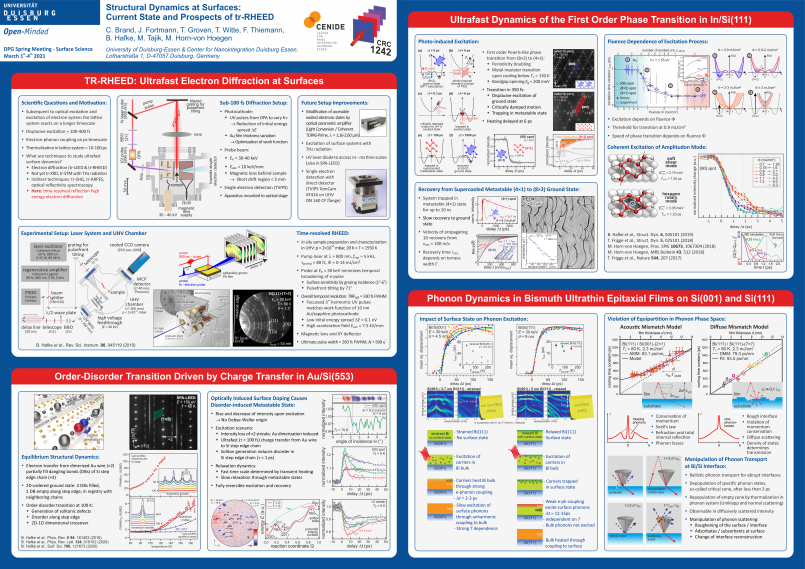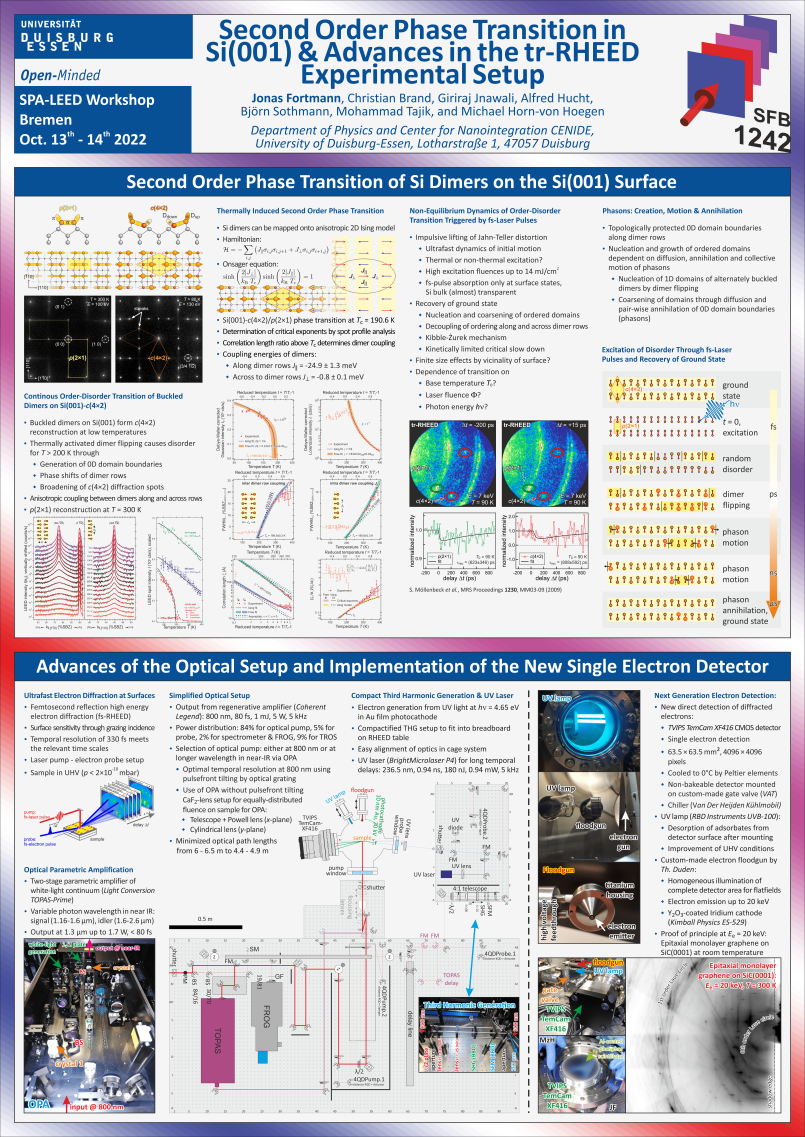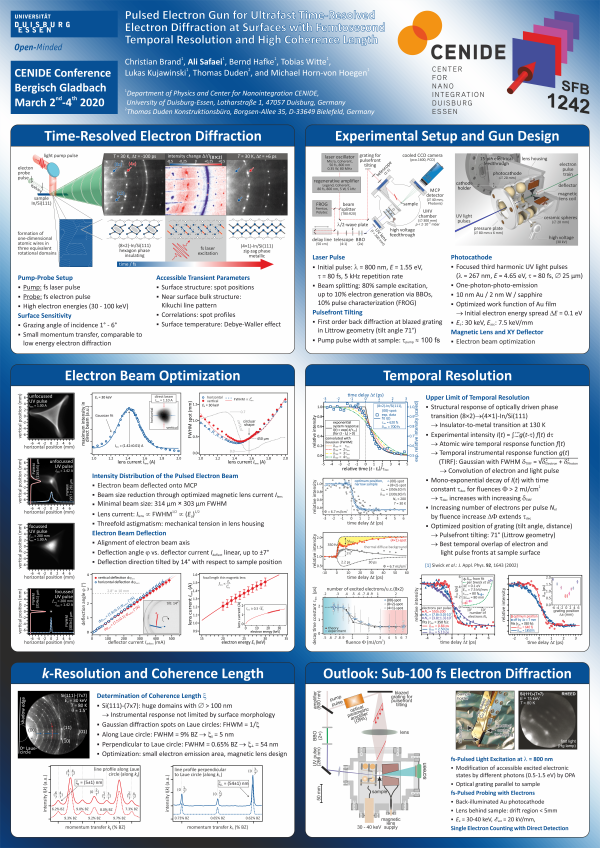Overview of project C03
Driven Phase Transitions at Surfaces: Initial Dynamics, Hidden States and Relaxation
The non-equilibrium structural dynamics of driven phase transitions at single crystal surfaces upon femtosecond laser excitation is studied by means of ultra-fast electron diffraction with femtosecond temporal and sub-Ångstrom spatial resolution.

The focus is on a fundamental understanding of the relevant mechanisms, which initiate the phase transition, the geometric paths of the ultrafast collective motion of the atoms during the transition, of metastable states of matter which cannot be reached under equilibrium conditions, and the processes which causes relaxation to the ground state.
We employed the drosophila of atomic wire systems, i.e., the (4x1) reconstructed In atomic wires on well oriented Si(111) surface which undergoes a Peierls like symmetry breaking at Tc = 130 K. During this structural phase transition of first order the system doubles the periodicity along and perpendicular to the wires resulting in a (8x2) reconstructed ground state. Upon intense photo excitation the (8×2) state is driven in 700 fs to the (4×1) excited state as observed through time resolved RHEED spot intensity at an overall temporal resolution of 350 fs (FWHM). Transient heating of the In atoms from 30 to 60 K occurs delayed on a time scale of 2.2 ps. Thus, the phase transition is driven by electronic entropy and not thermally. An energy barrier for the atoms collective motion from the excited (4x1) state to the (8x2) state hinders the immediate recovery of the ground state: the In layer remains for more than 10 ns in a super cooled metastable (4×1) state, which is not accessible under equilibrium conditions. The relaxation into the (8×2) ground state happens through the nucleation of the (8×2) at pre-existing defects like adsorbates [or step edges which trigger a recrystallization front. This front propagates 1-dimensionally at a speed of ~100 m/s as determined from a correlation of the step morphology to recovery time constant.
Publications
2025
Jonas D. Fortmann, Alexander Kaßen, Christian Brand, Thomas Duden and Michael Horn-von Hoegen
Implementation and Performance of a Fiber-Coupled CMOS Camera in an Ultrafast Reflective High-Energy Electron Diffraction Experiment
Struct. Dyn. 12, 024301 (2025)
DOI: 10.1063/4.0000284
Gernot Schaller, Friedemann Queisser, S.P. Katoorani, Christian Brand, Christian Kohlfürst, Mark R. Freeman, Alfred Hucht, Peter Kratzer, Björn Sothmann, Michael Horn-von Hoegen and Ralf Schützhold
Kibble-Zurek Dynamics in the Anisotropic Ising Model of the Si(001) Surface
Phys. Rev. Lett. 134, 246202 (2025)
DOI: 10.1103/rmc4-xqb3
Christian Brand, Tobias Witte, Mohammad Tajik, Jonas D. Fortmann, Birk Finke, Herbert Pfnür, Christoph Tegenkamp and Michael Horn-von Hoegen
Thermal Boundary Conductance under Large Temperature Discontinuities of Ultrathin Pb(111) Films on Si(111)
Appl. Phys. Lett. 127, 172202 (2025)
DOI: 10.1063/5.0291617
2024
Wei Lu, Matthieu Nicoul, Uladzimir Shymanovich, Alexander Tarasevitch, Michael Horn-von Hoegen, Dietrich von der Linde and Klaus Sokolowski-Tinten
A Modular Table-Top Setup for Ultrafast X-Ray Diffraction
Rev. Sci. Instrum. 95, 013002 (2024)
DOI: 10.1063/5.0181132
Christian Brand, Alfred Hucht, Hamid Mehdipour, Giriraj Jnawali, Jonas D. Fortmann, Mohammad Tajik, Rüdiger Hild, Björn Sothmann, Peter Kratzer, Ralf Schützhold and Michael Horn-von Hoegen
Critical Behavior of the Dimerized Si(001) Surface: Continuous Order-Disorder Phase Transition in the Two-Dimensional Ising Universality Class
Phys. Rev. B 109, 134104 (2024)
DOI: 10.1103/PhysRevB.109.134104
Fabian Thiemann, G. Sciaini, A. Kassen, T. S. Lott and Michael Horn-von Hoegen
Disentangling the Electronic and Lattice Contributions to the Dielectric Response of Photoexcited Bismuth
Phys. Rev. B 109, L041105 (2024)
DOI: 10.1103/PhysRevB.109.L041105
Michael Horn-von Hoegen
Structural Dynamics at Surfaces by Ultrafast Reflection High-Energy Electron Diffraction
Struct. Dyn. 11, 021301 (2024)
DOI: 10.1063/4.0000234
H. Pfnür, C. Tegenkamp, S. Sanna, E. Jeckelmann, Michael Horn-von Hoegen, Uwe Bovensiepen, N. Esser, W.G. Schmidt, M. Dähne, S. Wippermann, F. Bechstedt, M. Bode, R. Claessen, R. Ernstorfer, C. Hogan, M. Ligges, A. Pucci, J. Schäfer, E. Speiser, M. Wolf and J. Wollschläger
Atomic Wires on Substrates: Physics between One and Two Dimensions
Surf. Sci. Rep. 79, 100629 (2024)
DOI: 10.1016/j.surfrep.2024.100629
2023
Christian Brand, Alfred Hucht, Giriraj Jnawali, Jonas D. Fortmann, Björn Sothmann, Hamid Mehdipour, Peter Kratzer, Ralf Schützhold and Michael Horn-von Hoegen
Dimer Coupling Energies of the Si(001) Surface
Phys. Rev. Lett. 130, 126203 (2023)
DOI: 10.1103/PhysRevLett.130.126203
Azize Koç, Isabel Gonzalez-Vallejo, Matthias Runge, Ahmed Ghalgaoui, Klaus Reimann, Laurenz Kremeyer, Fabian Thiemann, Michael Horn-von Hoegen, Klaus Sokolowski-Tinten, Michael Woerner and Thomas Elsaesser
Quantum Pathways of Carrier and Coherent Phonon Excitation in Bismuth
Phys. Rev. B 107, L180303 (2023)
DOI: 10.1103/PhysRevB.107.L180303
Karim Omambac, Marko A. Kriegel, Marin Petrović, Birk Finke, Christian Brand, Frank Meyer zu Heringdorf and Michael Horn-von Hoegen
Interplay of Kinetic Limitations and Disintegration: Selective Growth of Hexagonal Boron Nitride and Borophene Monolayers on Metal Substrates
ACS Nano 17, 17946 (2023)
DOI: 10.1021/acsnano.3c04038
2020
Bernd Hafke, Christian Brand, Tobias Witte, Björn Sothmann, Michael Horn-von Hoegen and S. C. Erwin
Thermally Induced Crossover from 2D to 1D Behavior in an Array of Atomic Wires: Silicon Dangling-Bond Solitons in Si(553)-Au
Phys. Rev. Lett. 124, 016102 (2020)
DOI: 10.1103/PhysRevLett.124.016102
Bernd Hafke, Tobias Witte, Christian Brand and Michael Horn-von Hoegen
Adsorbate Induced Manipulation of 1D Atomic Wires: Degradation of Long-Range Order in the Si(553)-Au System
Surf. Sci. 700, 121673 (2020)
DOI: 10.1016/j.susc.2020.121673
2019
Bernd Hafke, Tobias Witte, Christian Brand, Thomas Duden and Michael Horn-von Hoegen
Pulsed Electron Gun for Electron Diffraction at Surfaces with Femtosecond Temporal Resolution and High Coherence Length
Rev. Sci. Instrum. 90, 045119 (2019)
DOI: 10.1063/1.5086124
Bernd Hafke, Tobias Witte, David Janoschka, Pascal Dreher, Frank Meyer zu Heringdorf and Michael Horn-von Hoegen
Condensation of Ground State from a Supercooled Phase in the Si(111)-(4×1) → (8×2)-Indium Atomic Wire System
Struct. Dyn. 6, 045101 (2019)
DOI: 10.1063/1.5111636
2018
Tim Frigge, Bernd Hafke, Tobias Witte, Boris Krenzer and Michael Horn-von Hoegen
Non-Equilibrium Lattice Dynamics of One-Dimensional In Chains on Si(111) upon Ultrafast Optical Excitation
Struct. Dyn. 5, 025101 (2018)
DOI: 10.1063/1.5016619
Michael Horn-von Hoegen
Optically Excited Structural Transition in Atomic Wires on Surfaces at the Quantum Limit: a Femtosecond Ultrafast Surface Electron Diffraction Study
Proc. SPIE 10673, Advances in Ultrafast Condensed Phase Physics, 1067304 (2018)
DOI: 10.1117/12.2312239
Michael Horn-von Hoegen
Ultrafast Switching in an Atomic Wire System at Surfaces
MRS Bulletin 43, 512 (2018)
DOI: 10.1557/mrs.2018.150
2017
Tim Frigge, Bernd Hafke, Tobias Witte, Boris Krenzer, Carla Streubühr, Abdul Samad Syed, Vesna Mikšić Trontl, Isabella Avigo, Ping Zhou, Manuel Ligges, Dietrich von der Linde, Uwe Bovensiepen, Michael Horn-von Hoegen, Stefan Wippermann, Andreas Lücke, Simone Sanna, Uwe Gerstmann and Wolf Gerp Schmidt
Optically Excited Structural Transition in Atomic Wires on Surfaces at the Quantum Limit
Nature 544, 207 (2017)
DOI: 10.1038/nature21432
2016
Bernd Hafke, Tim Frigge, Tobias Witte, Boris Krenzer, Julian Aulbach, Jörg Schäfer, Ralph Claessen, Steve C. Erwin and Michael Horn-von Hoegen
Two-Dimensional Interaction of Spin Chains in the Si(553)-Au Nanowire System
Phys. Rev. B 94, 161403 (2016)
DOI: 10.1103/PhysRevB.94.161403



